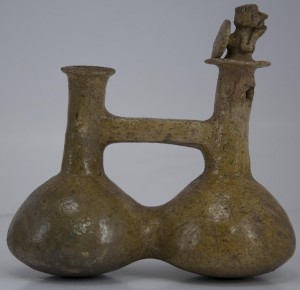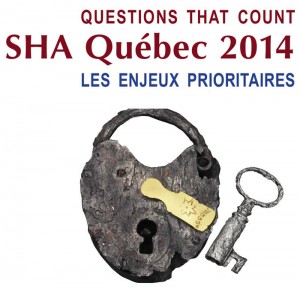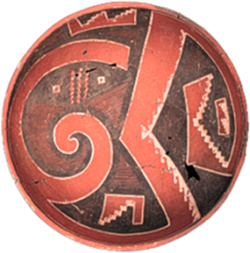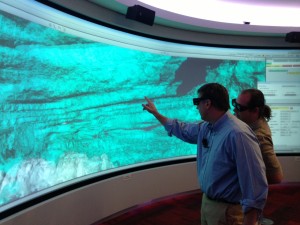Anthropology Department Blog
Posted: January 31st, 2014 by dblom
 Teresa Mares has recently published a chapter entitled “Engaging Latino Immigrants in Seattle Food Activism Through Urban Agriculture” in the volume Food Activism: Agency, Democracy, and Economy, edited by Carole Counihan and Valeria Siniscalchi (Bloomsbury, 2014).
Teresa Mares has recently published a chapter entitled “Engaging Latino Immigrants in Seattle Food Activism Through Urban Agriculture” in the volume Food Activism: Agency, Democracy, and Economy, edited by Carole Counihan and Valeria Siniscalchi (Bloomsbury, 2014).
Faculty Research, Promote to Website | No Comments »
Posted: January 28th, 2014 by dblom
 Parker VanValkenburgh received funding from the University of Missouri Research Reactor (MURR) to conduct Instrumental Neutron Activation Analysis (INAA) on samples of archaeological ceramics from Peru’s north coast region. INAA is a technique used to identify the concentrations of trace and major elements in a variety of materials, and VanValkenburgh and colleagues Sarah Kelloway (University of New South Wales) and Jeffrey Quilter (Harvard University) will be employing it to trace patterns of production in a unique type of early colonial ceramics called Early Green Glazed (EGG) Ware. EGG Ware vessels, like the one pictured in the attached photograph, have classically prehispanic-style forms but incorporate a decorative technique (glazing) that was unknown in the Americas before the Spanish colonial era. Archaeologists and historians have seen such pieces as iconic elements of contact between native and Spanish traditions, but they have never been systematically studied, until now.
Parker VanValkenburgh received funding from the University of Missouri Research Reactor (MURR) to conduct Instrumental Neutron Activation Analysis (INAA) on samples of archaeological ceramics from Peru’s north coast region. INAA is a technique used to identify the concentrations of trace and major elements in a variety of materials, and VanValkenburgh and colleagues Sarah Kelloway (University of New South Wales) and Jeffrey Quilter (Harvard University) will be employing it to trace patterns of production in a unique type of early colonial ceramics called Early Green Glazed (EGG) Ware. EGG Ware vessels, like the one pictured in the attached photograph, have classically prehispanic-style forms but incorporate a decorative technique (glazing) that was unknown in the Americas before the Spanish colonial era. Archaeologists and historians have seen such pieces as iconic elements of contact between native and Spanish traditions, but they have never been systematically studied, until now.

On January 10th, Dr. VanValkenburgh also co-organized a session at the Society for Historical Archaeology annual meetings entitled “Las preguntas que cuentan: Ideas and interpretations in Latin American historical Archaeology.” The full-day session, hosted jointly with Ross Jamieson (Simon Fraser University) featured work by over 20 scholars conducting research in a growing and dynamic field — the archaeology of Latin American sites dating after the Spanish Invasion of the Americas.
Faculty Research, Uncategorized | Comments Off on Latest Research by Our New Prof — Dr. Parker VanValkenburgh
Posted: January 26th, 2014 by tmares
In 2014, UVM will host the 33rd annual meeting of the Northeast Conference in Andean Archaeology and Ethnohistory, one of three annual gatherings that showcase new research in Andeanist anthropology. Currently, UVM is one of only a handful of institutions hosting two scholars of Andean archaeology and material culture (Dr. Blom and Dr. VanValkenburgh). Anthropology will serve as the host department for the conference but has also brought onboard Assistant Professor of Spanish Martín Oyata and Professor Emeritus of Geography Daniel Gade to increase its interdisciplinary impact. [tentative schedule: 3rd week in October, 2014]
Events, Faculty Research | No Comments »
Posted: January 26th, 2014 by tmares
Enhancing Excellence through the Interdisciplinary Experiential Engagement is an initiative that promotes high-impact educational experiences that address questions or topics using a interdisciplinary approach, which facilitates the understanding and appreciation of the complexity and interconnectivity of phenomena and improves students’ ability to synthesize and integrate information. The two awards given this year were awarded to Anthropology faculty collaborating with faculty in other disciplines:
“Interdisciplinary Museum Studies” Drs. Jennifer Dickinson (Anthropology) and Kelly DiDio (Art History) [course to be offered Fall 2014]
“Interdisciplinary Engagement in Human Diversity and Evolution” Drs. Deborah Blom (Anthropology) and Amanda Yonan (Biology) [course to be offered Spring 2015]
Congratulations Dr. Dickinson and Dr. Blom!!
Funding, Teaching | No Comments »
Posted: January 26th, 2014 by dblom
Dr. Shea’s article entitled “Revolutionary Narratives of Self-Compassion among Older Women in Post-Mao Beijing” will be published in an April 2014 special issue of the journal Anthropology and Medicine on social suffering and compassion in Chinese cultural settings. The article traces how middle-aged and young-old Chinese women came to express and embody a theme of post-revolutionary self-compassion through various forms of self-care in the market reform years following the self denying eras of the pre-Mao and Maoist eras.
Additionally, Dr. Shea is a member of research team undertaking cross-national collaborative research on aging in China and the US. The team, which also includes scholars from Washington University at St. Louis and Fudan University (China), was just awarded funding through the Global Aging Initiative of the Harvey A. Friedman Center for Aging.
Faculty Research | Comments Off on Anthropology Professor Jeanne Shea’s Recent Research Successes
Posted: January 15th, 2014 by tmares
Check out this story about a UVM senior who is applying the major in Anthropology to thesis research on social implications of genetic and genomic testing in Vermont as he prepares for a career in medicine and public health.
Student/Affiliate Research | No Comments »
Posted: January 13th, 2014 by tmares
Abraham Awolich (Class of 2006) was recently featured in The New York Times and The Burlington Free Press for his work with The Sudan Development Foundation, an organization that he co-founded after completing his undergraduate degree in anthropology at UVM and his graduate degree in public administration at Syracuse University. Amidst the conflict in South Sudan, Abraham is doing important work helping to run and provide supplies to a medical clinic and a facility for mothers and small children, among other projects. Read the New York Times piece and the Burlington Free Press piece for updates on his work and visit the Sudan Development Foundation’s website for more information.
Alumni News | No Comments »
Posted: December 5th, 2013 by dblom
Anthropology professor Teresa Mares with Geography professor Pablo Bose speak about their research on food and migration in Vermont, particularly their involvement with two community projects – one that works with refugees on urban farming, and another that works with migrant workers on kitchen gardening. Through this talk, Drs. Bose and Mares provide a deeper understanding of the connections among food, culture, and migration. See video of talk here.
Faculty Research | No Comments »
Posted: December 4th, 2013 by tmares

An article detailing Scott Van Keuren’s research on southwestern pottery appears in the December issue of Journal of Anthropological Archaeology. The article shows how a high-tech compositional analysis of paints revealed that only certain potters had access to the knowledge and resources required to craft a richly-decorated pottery type. The study is part of a broader research project supported by the National Science Foundation that seeks to understand the transformation of Ancestral Pueblo society in portions of eastern Arizona in the centuries just prior to European contact. The article was co-authored with former UVM undergraduate Mark Agostini, whose participation in the project was supported by a Research Experiences for Undergraduates award from NSF.
Alumni News, Faculty Research, Student/Affiliate Research | No Comments »
Posted: November 19th, 2013 by dblom

Dr. Crock at CAVEA Theatre, MSU
John Crock presented “3D Modeling and visualization of Amerindian Cave Sites and Rock Art in the Caribbean” (with Wetherbee Dorshow, Ph.D.; Earth Analytic, Inc.) at the new Center for Advanced Visualization and Experiential Analysis (CAVEA) at Metropolitan State University of Denver on 11/6/2013. This technology allows a 3D rendering of caves containing rock art from Anguilla, which have made visible petroglyphs invisible to the naked eye. He also presented at University Colorado Colorado Springs on 11/5. The abstract of the talk at CAVEA follows:
Recent use of a Faro laser scanner to map caves and other sites with prehistoric rock art in Anguilla, British West Indies, demonstrates the utility of terrestrial LiDAR technology to help document, preserve and interpret significant archaeological sites that are often inaccessible to the general public. The results from Fountain Cavern, a ceremonial cave site with human-carved stalagmites and other rock art, and Big Spring, a limestone sink hole site with scores of petroglyphs, illustrate the utility of laser scanning in heritage management, specifically as a tool to enable highly fragile resources to be protected and preserved while also being made accessible within a digital 3D environment. The use of laser scanning to enhance the identification of rock art is also explored using the Anguilla to emphasize the interpretive value of three-dimensional representations of the artwork.
Faculty Research | No Comments »
 Teresa Mares has recently published a chapter entitled “Engaging Latino Immigrants in Seattle Food Activism Through Urban Agriculture” in the volume Food Activism: Agency, Democracy, and Economy, edited by Carole Counihan and Valeria Siniscalchi (Bloomsbury, 2014).
Teresa Mares has recently published a chapter entitled “Engaging Latino Immigrants in Seattle Food Activism Through Urban Agriculture” in the volume Food Activism: Agency, Democracy, and Economy, edited by Carole Counihan and Valeria Siniscalchi (Bloomsbury, 2014).





Recent Comments